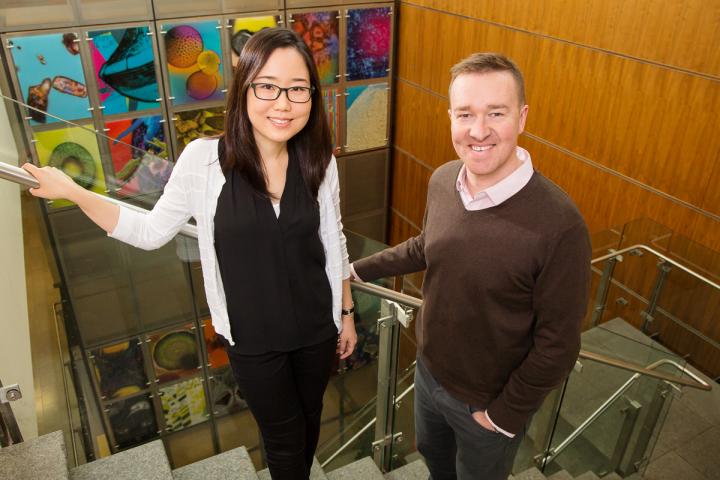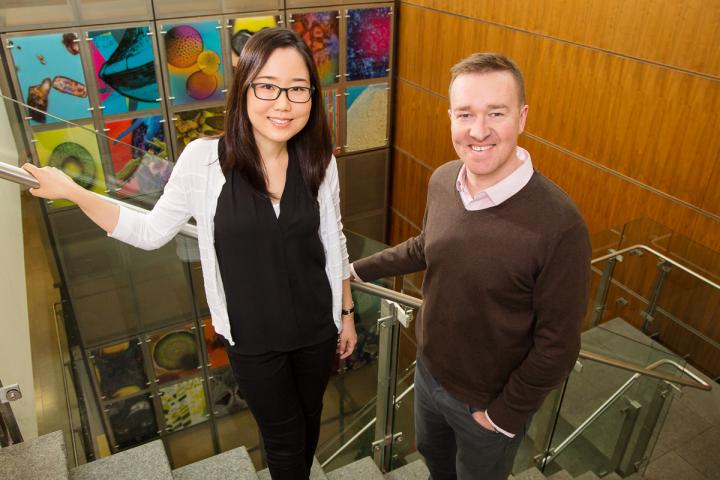
Credit: Photo by L. Brian Stauffer
CHAMPAIGN, Ill. — Researchers at the University of Illinois report they can alter blood cell development through the use of biomaterials designed to mimic characteristics of the bone marrow.
The findings, reported in the journal Science Advances, are a first step toward developing more effective bone marrow treatments for diseases like leukemia and lymphoma.
Blood cells flow throughout the body delivering life-supporting oxygen and nutrients. As these cells are used and recycled they are regenerated by bone marrow, the soft tissue inside the body's long and hollow bones.
Certain regions of bone marrow contain hematopoietic stem cells, the precursors of all blood and immune cells, said University of Illinois chemical and biomolecular engineering professor Brendan Harley, who led the research with postdoctoral researcher Ji Sun Choi.
"The tissue environment that surrounds these cells in the bone marrow provides a wealth of signals that can alter how these precursor cells behave. This paper looked at the signals provided by the tissue matrix itself," said Harley, who also is affiliated with the Carl R. Woese Institute for Genomic Biology at the U. of I.
One of the major tools that oncologists use to treat leukemia and lymphoma involves transplanting HSCs. The donor stem cells must locate marrow cavities and start producing blood and immune cells. However, there is a limited quantity of available donor HSCs and the success rate of transplantation is low.
"We're interested in this problem from an engineering standpoint," Harley said. "The goal is to create better tools to both expand the number of donor HSCs and improve their capacity to repopulate the bone marrow after transplantation."
Like cells throughout the body, HSCs are contained in a three-dimensional tissue environment known as the extracellular matrix. Harley and Choi gathered samples of HSCs from mice and then grew them in the laboratory using biomaterials engineered to mimic some of the extracellular matrix properties of the native bone marrow. Their goal was to examine how these engineered systems could alter the HSCs' capacity to proliferate and differentiate to become blood cells.
The researchers examined two main elements of the matrix that regularly interact with HSCs: collagen and fibronectin. They found that the HSCs that were exposed to collagen proliferated more rapidly but that they had differentiated, meaning they were no longer stem cells. When exposed to fibronectin, the stem cells proliferated less rapidly, but were able to maintain their stem cell-like nature.
"With the collagen substrates, we got more cells but not useful cells," Harley said. "With the right combination of stiffness in the matrix and the presence of fibronectin, we identified a class of biomaterials that show promise for being able to maintain and eventually expand these stem cells outside of the body. An engineered bone marrow will be of enormous value for treating hematopoietic cancers such as leukemia, but also for understanding the process of bone marrow failure and other hematopoietic diseases."
This project is only the first step in controlling the signals from the matrix that influence HSCs, Harley said. He and other researchers in his lab are currently investigating other features of the matrix that can be manipulated to increase the number of stem cells and make them more effective in transplantation.
###
The National Science Foundation, National Institutes of Health and the American Cancer Society of Illinois supported this research.
Editor's notes:
To reach Brendan Harley, call 217-244-7112; email [email protected] [MAILTO].
The paper "Marrow-inspired matrix cues rapidly affect early fate decisions of hematopoietic stem and progenitor cells" is available online and from the News Bureau.
DOI: 10.1126/sciadv.1600455
Media Contact
Sarah Banducci
[email protected]
217-333-5802
@NewsAtIllinois
http://www.illinois.edu
############
Story Source: Materials provided by Scienmag





